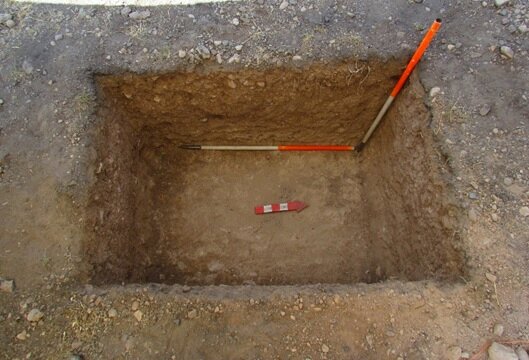Paleolithic hand ax discovered by archaeologists in northwest Iran

TEHRAN – Archaeologists have unearthed a hand ax during a demarcation project held in northwest Iran. The object is estimated to date from the Paleolithic era.
The hand ax was discovered in one of the trenches dug to help determine the legal boundaries of Khalilabad, an archaeological site in Showt county, which is situated in West Azarbaijan province, CHTN reported.
Supervised by the Research Institute for Cultural Heritage & Tourism (RICHT), the demarcation project is underway under the direction of Iranian archaeologist Leila Gargari, the report said.
The archaeologist stated that the purpose of speculation in this area is to identify cultural periods and to identify legal properties of the site to prevent the destruction of this important cultural place.
Due to the abundance of similar stone structures so far being discovered in Khalilabad, the history of the site can be traced back to the Paleolithic period, Gargari said.
The hand ax and many other similar objects discovered in the area are made of chert (which is a hard, fine-grained sedimentary rock composed of microcrystalline or cryptocrystalline quartz), she noted.
Furthermore, a new study reinforces a hypothesis that the Iranian plateau was like a bridge between East and West during the Pleistocene epoch, which began about 2.6 million years ago and lasted until about 11,700 years ago. In an article published in the International Research Journal of Modernization in Engineering Technology and Science (IRJMETS) in April 2021, Iranian researchers Mohsen Zeidi, Cyrus Barfi, and Shahram Zare concluded that the Iranian plateau served as a human migratory pathway in the Pleistocene.
“Increasing Paleolithic finds in this region and neighboring countries (Pakistan and Afghanistan) reinforces the hypothesis that the Iranian Plateau has been used as a human migratory pathway in the Pleistocene linking East and West.”
Based on the field observations, the surveyed areas seem to be mostly undisturbed through natural and modern human activities and our initial insight suggests that surface scatters of stone tools and debitage are usually located in the large area along the drainages and seasonal river terraces where probably water sources were attractive to the Pleistocene hominins. However, documenting the full extent of the localities and their lithic scatter needs further intensive survey.
Since the early 20th century, the Iranian plateau has undergone several Paleolithic-based research. The German geologist Reinhold von Huckriede discovered a late Mesolithic site near Kuhbanan in Kerman in the framework of his geological investigations.
In 1964, Gary W. Hume at the request of Joseph R. Caldwell, director of the Kerman project explored the potential for Paleolithic sites in Bardsir valley near Kerman. Moreover, a later archaeological investigation in the Bam-Narmashir region of Kerman province revealed several archaeological sites dating from the Neolithic period to the Iron Age.
Throughout history, the big and sprawling Kerman region has been something of a cultural melting pot, blending various regional cultures over time. It is bounded by the modern provinces of Fars on the west, Yazd on the north, South Khorasan on the northeast, Sistan-Baluchestan on the east, and Hormozgan on the south.
AFM
